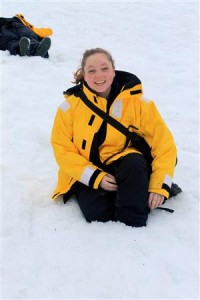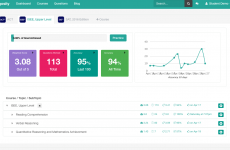When deciding on how to best utilize the skills she gained as a bioengineering undergraduate at Rice University, the possibilities seemed endless. But for Rachel Alexander, there seemed to be no better fit than teaching high school students how to use engineering and computer science principles in their everyday life.
Rachel will be starting her third year as an engineering design teacher this fall at Reagan High School located in the Houston Heights. Building off of strategies learned in her first two years, Rachel is hopeful and expectant of new triumphs and lessons to be learned for both herself and her students in the upcoming school year. Rachel was kind enough to take time out of her busy schedule of preparing lesson plans and readying her classroom to talk to ThesisMag about the highs and lows of teaching and what’s in store for her this year.
What’s new for the 2014-2015 school year at Reagan High School?
“Of 135 students last year, only about 20 were girls…this year (nearly 40% are girls).”
As a teacher, every day is different. For Rachel, the surprises of each day help keep her motivated. Starting in the 2014-2015 school year, changes to Texas diplomacy standards enacted by the legislature outlined in HB 5 are providing students with the opportunity to choose course pathways or “mini majors.” This means that teachers like Rachel, who teach electives as opposed to core subjects like English or math, will have slightly more on their plate in order to mold effective paths for students to follow.
This year, Rachel is moving from teaching Computer Science to Engineering Design, instructing 3 different sections of mostly freshmen and sophomores the basics of engineering and engineering design. Last year, Rachel started using the Arduino microcontroller to teach her students about the foundations of computer science.
In making the switch, she hopes that the program won’t be lost as a new teacher takes over for teaching the school’s computer science classes.. Speaking about the change, Rachel mentions, “I convinced her to stick with the program for this upcoming year, so I’ll be giving her lots of support in continuing the program.”
Rachel noted that because nearly 75% of the students come from low-economic areas (with nearly 30-40% being considered at-risk), some of her students were behind in their foundational math and knowledge skills. Because the knowledge and application of those skills are so critically important in traditional computer science and engineering courses, Rachel had to find a different approach.
Rachel chose to use the Arduino microcontroller program because it helps the students focus on the concept of learning computer science, rather than struggling to compute incessant sequences of numbers . While the Arduino system is more for hobbyists tinkering with electronics, it provides the students with a gateway to a subject once closed to those with limited STEM knowledge.
The students who consider continuing an education in computer science and engineering will eventually have to learn those math and science skills to advance in the field. However, Rachel’s Arduino-based curriculum has helped open doors for many of her students. “I’ve had a few students tell me they want to continue learning about computer science in the future,” she notes.
Considering the demographic makeup of Reagan High School, Rachel’s innovative approach to teaching both engineering and computer science offers her students the opportunity to learn the sometimes intimidating subjects with confidence. Rachel is also looking forward to having an increased number of girls in her class. “Of 135 students last year, only about 20 were girls. But looking at this year’s roster, that number seems like it might have gone up.” *Editor’s note: Rachel’s updated roster now shows about 40% of the class will be female students.
Asked about how the school’s budget affects her lesson plan, Rachel says that there are “always problems with the budget.” Despite this, she’s got a positive perspective: “It doesn’t hinder my lesson plans. It just forces me to be more creative with what I have.” Rachel keeps a closet of “junk” materials, like old computer parts and accessories, to get her students in on the fun of using their brains to make things work.
Pondering what she would ask for, if offered a dream gift from the district to help make her class more effective, the reality of space constraints became apparent. “If I could have anything in particular, I’d ask for an engineering lab or a workspace for my students. We’ve had a increase in the student population and often have to share space. I teach my students to work with traditional engineering tools, like soldering irons. It would be nice to have a space to make a mess without worrying about damaging anything for another class.” Rachel notes the lack of space will be an interesting challenge for the upcoming year. “It’ll be fun to see how to fit 35 kids in a 30 ft. x 30 ft. room.”
Making A Connection with the Students
“Most of the time, I’m on my feet.”
“I really only use my desk for grading papers,” Rachel says, describing her approach to teaching her students. “Most of the time, I’m on my feet. I don’t like to lecture much, usually only two or three times a week.”
She prefers to minimize time standing in front of students, instead utilizing more hands-on, application based techniques, like teaching her students how to use the Arduino microcontroller. “I have a much more positive response from students when they’re busy. They stay on task more and are less prone to distractions when they’re working with something [tangible].”
Rachel approaches teaching from more a supervisory role when her students are busy with their projects, walking and talking to students during the period, answering questions, monitoring safety practices and encouraging them to “take the project further.” “I always want them to do more with what they’re learning,” she says.
She’s also recognized that her approach helps with minimizing disciplinary issues. “As long as the lesson is engaging, the kids are great. If they’re bored, they’re more prone to discipline problems.” Rachel says when behavioral problems do crop up, it’s usually a sign to modify the lesson. “If something doesn’t work and my students aren’t engaged, I know it’s because there’s usually an issue with that part of the lesson, so I note it and take it out next time.”
Her content’s relevancy helps in teaching. A lesson about remote controls helped things connect for her students. Teaching about how infrared wireless transmission made television remote controls and many other devices work, her students began to understand the necessity of engineering in their everyday lives.
In such an increasingly digital age, nearly every device used each day requires some sort of programming aspect in its development. Her students are benefitting from the lessons. “The technical skills they’ve gained could help them earn programming and IT jobs in the future, should they continue their education,” Rachel says. “Computer science and engineering design skills apply to anything digital. Technology changes drastically at least once every 5 years.” Even if her students don’t take the full programming route, they will still be able to apply their knowledge as problem solvers for businesses IT needs.
Life as a Teacher
“Had you ever considered that I might be here because I wanted to teach and enjoy students?”
Though she’s had great success so far in her short teaching career, it hasn’t come without cost. A 2012 graduate of Rice University’s bioengineering program, Rachel made a difficult decision with how to best use her knowledge and skills.
Teaching isn’t necessarily the first option for most engineering majors. “I’d say about half of my friends are now in grad school or med school. The rest are doing some form of consulting.” Rachel says that at times, the social stigma of teaching is frustrating. “I get looked down upon by some because I chose to teach. But, my job is so rewarding and I’m very happy because I picked the right path for me.”

Rachel said her prestigious degree was a little imposing to some, but that she’s really quite easy going!
The Tulsa, Oklahoma native admitted she struggled with telling her parents about her decision to teach. “Here I am, my parents spending nearly a quarter of a million dollars to send me to Rice, and I’m just supposed to say, ‘Hey mom and dad, I’m going to be a teacher now.’ But they’ve been very supportive.”
She admits, her degree initially caused some confusion when she started working at Reagan. “The first day, all of the teachers were introducing themselves. When it was my turn and I said I graduated with an engineering degree from Rice, there was a slight gasp and the room got quiet. I thought “Oh no, I’m not going to make any friends here [laughing].”
She says that even the students can be apprehensive about receiving her instruction because of her degree. “Sometimes they’ll assume I’m not as smart or as good an engineer because I chose to teach. They ask ‘why are you here?’ And sometimes I want to ask them, ‘Had you ever considered that I might be here because I wanted to teach and enjoy students?’”
Her impressive degree seems to have helped in gaining support from the school’s administration and HISD. They funded the cost of implementing the Arduino hardware into her curriculum, with little idea of how it might turn out. “I think my degree helps in asking for certain [teaching aids] because they feel like they can have faith that I’ll produce good results.”
In addition to teaching, Rachel also coaches Reagan High School’s robotics team. “It’s awesome getting to work with the students one-on-one,” she says about the after-school program.
Rachel says she enjoys the long hours, saying it’s essentially a necessity for her to do her job well. “I’m usually at school around 7am and I may be there until 11pm working on lesson plans and grading. Then I go home, finish up my lesson plans and start all over again the next day.”
Rachel notes that she feels teaching is a good fit for her because she doesn’t get stressed very easily: “I care a lot about my job and my students. It makes any of the stress worthwhile.” Reflecting on the previous year when she taught graduating seniors, she says wistfully, “I will miss a lot of them.”
Rachel’s passion and dedication translates into noted benefits for her students, sharing that she sees them gaining more confidence in themselves and their abilities. “When I see my students understanding the lesson and getting excited about learning, I hope they will pursue learning more, and growing more passionate in their educational pursuits.”
Though she loves her students, she notes that she has had to overcome some obstacles in reaching them at times. “Reagan’s student population is about 88% Hispanic, so there have definitely been some issues with language barriers between myself and some of the parents,” Rachel recalls.
Despite these challenges, Rachel remains hopeful and happy, looking forward to the new school year and her future as a teacher. “I’m not exactly sure where life is going to take me in the next few years, but I’m definitely going to stay in education,” she declares. One of her goals is to begin writing curriculum and textbooks for engineering design students. She’s also considered moving into greater educational leadership roles, helping develop summer enrichment programs for students.
Rachel finishes the conversation with wise words as she continues getting ready for the semester. “I love my job because I get to decide how every day goes. I get to set the tone for things will be.”
As our conversation concludes, Rachel leaves a distinctive hope and anticipation that our society may soon be fortunate enough to have more teachers like her, building our students and making an impact on our educational system.
A 2012 graduate from Rice University with a BS in Bioengineering, Rachel is beginning her third year as a teacher at Houston Independent School District’s Reagan High School. While an undergraduate at Rice, Rachel tutored with Thesis’s publisher, General Academic, in a range of subjects including, math, science, and standardized test preparation.
—
* Article updated on 8/22/14 to add block quotes and a brief bio about Rachel at the end.
















Pingback: Personal Perspectives in Education: Rachel Alexander